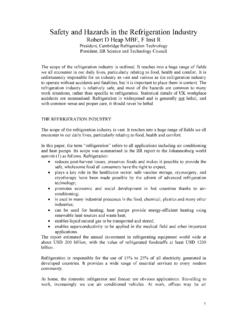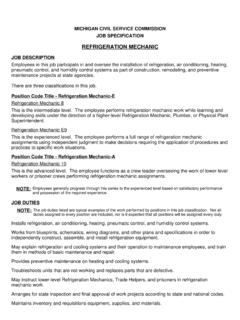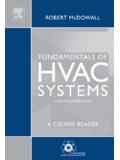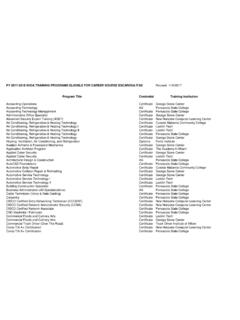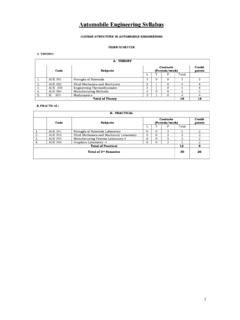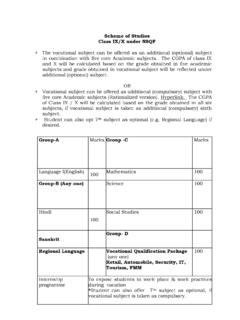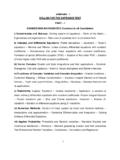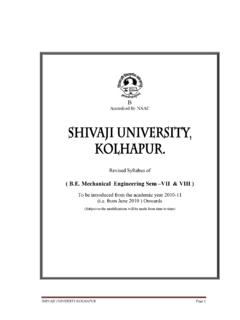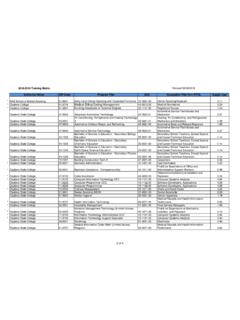Transcription of VENTILATION EFFECTS AND REQUIREMENTS IN …
1 ICR0472. VENTILATION EFFECTS AND REQUIREMENTS . IN CONTAINERISED REFRIGERATED TRANSPORT. Robert HEAP, Richard MARSHALL. Cambridge refrigeration Technology, 140 Newmarket Road, Cambridge CB5 8HE, UK. Tel: +44 1223 365101, Fax: +44 1223 461522, ABSTRACT. Fresh fruits and vegetables are alive and require fresh air to allow respiration. Without VENTILATION during transport, respiratory gases can build up and damage the produce. Historically, high VENTILATION rates have been used, which impact unfavourably on temperature control, humidity, and energy use. Calculation programs are now available which allow easy calculation of VENTILATION REQUIREMENTS in containerised transport for given upper levels of carbon dioxide or ethylene.
2 These programs are described and are used to compare necessary VENTILATION rates with those generally used in transport. It is shown that, for produce with low rates of respiration, VENTILATION rates are generally appreciably higher than necessary. INTRODUCTION. The majority of refrigerated containers are designed for the carriage of both chilled and frozen cargoes. Many chilled cargoes comprise perishable produce, fruits or vegetables that require VENTILATION with fresh air to maintain a satisfactory storage atmosphere. Most refrigerated containers therefore incorporate VENTILATION arrangements.
3 For chilled cargoes, temperature controlled air is circulated around the cargo by fans at a rate of around 4,000 m3 /h. Fresh air REQUIREMENTS vary in the range from 25 to 250 m3 /h and are typically in the range 25 to 75 m3 /h. If the VENTILATION rate is too low, produce may suffer from build-up of carbon dioxide or ethylene. Increased VENTILATION has EFFECTS on the refrigeration system operation: more cooling power is needed, more moisture is introduced resulting in a greater need for defrosting, close temperature control becomes more difficult, more energy is used. In most refrigerated containers, the rate of fresh air VENTILATION is set at loading and does not vary.
4 For satisfactory carriage without excessive energy use, it is important to set the correct VENTILATION rate, neither too high nor too low. 1 RESPIRATION AND VENTILATION . All vegetables and fruits are alive and continue to respire and metabolise. The metabolic process evolves carbon dioxide and metabolic heat. There is a clear relationship between heat of metabolism and evolution of carbon dioxide, and for every watts of metabolic heat 1g of C02 is generated. This is discussed fully in ASHRAE. (1998). Respiration may also release water vapour and ethylene. The level of respiration is dependent on produce type and on temperature.
5 It also varies with produce maturity. For example, at 0 C, Thompson seedless grapes produce watts per tonne, whereas sprouting broccoli produces watts per tonne. The variation with temperature is illustrated in table 1, with data from ASHRAE (1998). From this it is seen that substantial amounts of carbon dioxide may be produced, but the amount will vary over a wide range. To prevent excessive build-up of carbon dioxide, VENTILATION is necessary. Too much carbon dioxide can produce tissue damage or fizzy fruit; in apples this condition is known as brown heart. Without VENTILATION there can also be a lack of oxygen, which can result in anaerobic respiration; in this case the metabolic pathway is incomplete and the final product becomes alcohol resulting in alcoholic tasting fruit.
6 Too much water vapour can encourage the development of moulds, rots and fungi. However, too little is just as bad as it results in desiccation of fruit and vegetables. Ethylene gas is a ripening hormone, very small quantities building up can promote premature International Congress of refrigeration 2003, Washington. 1. ICR0472. ripening in fruit or de-greening in green vegetables and loss of leaves. It also can cause abortion of embryonic flowers in bulbs. Table 1. Metabolic heat production of sprouting broccoli Temperature, C Metabolic heat, W/tonne 0 5 102-475. 15 515-1008. 20 843-1011.
7 25 1155-1661. 2 refrigeration IMPLICATIONS. Any VENTILATION will increase the need for cooling, as the air introduced must be cooled to the cargo carriage temperature. Humidity introduced in the fresh air will need to be removed, requiring still more cooling power and also leading to more frequent or longer defrosting periods. Thus VENTILATION can add substantially to cooling power REQUIREMENTS . A VENTILATION rate of 100 m3 /h of air at 20 C above the cargo temperature requires about 650 watts of sensible cooling, which can be more than doubled by latent cooling to remove excess humidity.
8 The addition of fresh air at one point in the container can lead to loss of uniformity of temperature control across the width of the container, leading to a wider temperature range within the cargo. Whilst VENTILATION is essential for many cargoes, excessive amounts of VENTILATION will increase energy use and reduce the quality of temperature control provided. It is therefore important to ensure that the correct amount of VENTILATION is supplied, no more and no less. 3 VENTILATION RATES. The VENTILATION rates of up to 250 m3 /h available in modern refrigerated containers are well in excess of those needed for most produce, so it is necessary to choose a reduced VENTILATION setting appropriate to the commodity being carried.
9 Shipping lines and equipment manufacturers provide guidelines, and a brief survey of some of these shows wide variations as follows: Apples (Gala) 30 125 m3 /h Asparagus 12 70 m3 /h Avocado (Haas) 30 125 m3 /h Broccoli 30 125 m3 /h Faced with this range, how does the shipper decide what to select? What is needed is a simple-to-use calculation program to show the EFFECTS of different VENTILATION rates. 4 CALCULATION PROGRAMS. The gas calculation program is a tool designed to enable the user to predict the level of gas concentration in a volume of space after a length of time. Gas calculation programs are available from a number of sources; one developed for easy use is described here.
10 The tool uses a general expression widely recognised in Building Services which encompasses a number of variables. It gives the user easy access to find the stabilisation period and final gas concentration resulting from set VENTILATION and gas production rates. After completing all the input parameters the program calculates the resultant gas concentration for a set duration and indicates the concentration stability by plotting the rate of change up to this point on a graph. International Congress of refrigeration 2003, Washington. 2. ICR0472. Growth and Decay Equation The equation is related to fluid dynamics and uses standard derivatives found in many books for calculating contamination growth and decay, Douglas et al.
